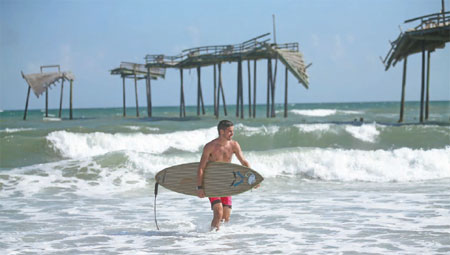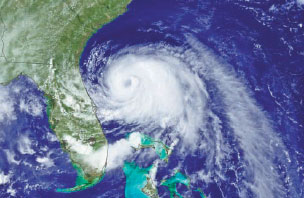Arthur grows to hurricane off US coast
Strom expected to weaken quickly, but many choose to evacuate homes
Tropical Storm Arthur became the first hurricane of the 2014 Atlantic season on Thursday, after sparking evacuations, closing beaches and tourist sites and disrupting Independence Day celebrations along parts of the US East Coast.
Arthur was about 300 kilometers south-southwest of Cape Fear, North Carolina, with maximum sustained winds of 120 km per hour, the US National Hurricane Center said after upgrading the strom's status.
It was moving at 15 kph in a northerly direction toward the coast and is expected to turn toward the northeast with an increase in speed on Thursday.
Authorities began closing campgrounds, lighthouses and beaches on the Outer Banks of North Carolina on Wednesday. Several towns and villages rescheduled Independence Day festivities and fireworks plans as the storm picked up speed.
North Carolina Governor Pat McCrory declared a state of emergency on Wednesday for 25 eastern counties to help prepare for possible damage.
Local businesses were worried about losses, though computer forecast models showed the hurricane was not a threat to key oil-and-gas producing areas in the Gulf of Mexico.
One local said that he was more worried about his tomato plants than storm damage.
But McCrory warned: "Don't put your stupid hat on".
In addition to the hurricane warning, tropical storm warnings were in effect for coastal areas in South Carolina and Virginia.
Gary Reinhardt, 63, and his wife Lori, both of Sarasota, Florida, said they planned to exit low-lying Hatteras Island on Thursday morning. So did nearly two dozen other family members from California, Nebraska and Michigan. A long line of cars, trailers and recreational vehicles already formed a steady stream of traffic before sunset Wednesday.
"I'm worried about the road. It took way too long to get here," said Gary Reinhardt, adding that the two-and-a-half-hour delay to get on the island came on Sunday, when there was no hurricane threat. Reinhardt worried their departure would take twice as long on Thursday.
Mike Rabe of Virginia Beach, Virginia, planned to stay in his beach home the entire weekend. He and his wife, Jan, arrived on Wednesday at the house they bought two and a half years ago and set to work stowing lawn furniture and anything else that could be tossed about by hurricane winds. He said he was going to spend Thursday helping a friend and longtime resident prep his nearby water sports shop and campground for bad weather.
"I'm going to help him prepare and then I'm going to ride it out," said Rabe, 53.
Arthur could be packing Category 1 hurricane-force winds of 135 kph when the outer bands brush the Carolinas on Thursday and Friday before weakening, forecasters said.
The storm could also cause dangerous rip currents, rainfall, fierce winds and flooding along coastal areas of Southern states.
Farther up the coast, the resort town of Ocean City, Maryland, said it was moving its July 4 fireworks display to Saturday because of the storm.
Boston officials also delayed a nationally televised concert by the Boston Pops and a fireworks display, which draw hundreds of thousands of spectators to the city's riverfront.
A tropical storm becomes a hurricane when maximum sustained winds reach 119 kph.
Reuters - AP
|
A Surfer enjoys the waves near the old damaged Hatteras Pier, on Wednesday in Cape Hatteras, North Carolina. By Wednesday evening, many residents were evacuating. Mark Wilson / Agence France-Presse |
|
A satellite image shows Arthur moving north off the east coast of Florida on Wednesday. Provided by Associated Press |
(China Daily 07/04/2014 page10)










